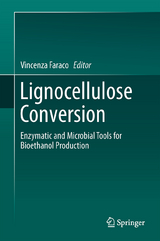Lignocellulose Conversion
Springer Berlin (Verlag)
978-3-642-37860-7 (ISBN)
Bioethanol has been recognized as a potential alternative to petroleum-derived transportation fuels. Even if cellulosic biomass is less expensive than corn and sugarcane, the higher costs for its conversion make the near-term price of cellulosic ethanol higher than that of corn ethanol and even more than that of sugarcane ethanol. Conventional process for bioethanol production from lignocellulose includes a chemical/physical pre-treatment of lignocellulose for lignin removal, mostly based on auto hydrolysis and acid hydrolysis, followed by saccharification of the free accessible cellulose portions of the biomass. The highest yields of fermentable sugars from cellulose portion are achieved by means of enzymatic hydrolysis, currently carried out using a mix of cellulases from the fungus Trichoderma reesei. Reduction of (hemi)cellulases production costs is strongly required to increase competitiveness of second generation bioethanol production. The final step is the fermentation of sugars obtained from saccharification, typically performed by the yeast Saccharomyces cerevisiae. The current process is optimized for 6-carbon sugars fermentation, since most of yeasts cannot ferment 5-carbon sugars. Thus, research is aimed at exploring new engineered yeasts abilities to co-ferment 5- and 6-carbon sugars. Among the main routes to advance cellulosic ethanol, consolidate bio-processing, namely direct conversion of biomass into ethanol by a genetically modified microbes, holds tremendous potential to reduce ethanol production costs. Finally, the use of all the components of lignocellulose to produce a large spectra of biobased products is another challenge for further improving competitiveness of second generation bioethanol production, developing a biorefinery.
Chapter 1. Introduction: potential of cellulosic ethanol Yoichi Honda Graduate School of Agriculture, Kyoto University, Kyoto 606-8502, Japan
Chapter 2. Lignocellulosic raw materials Yitzhak Hadar, Dep. of Plant Pathology and Microbiology, The Hebrew University of Jerusalem, Rehovot, Israel
Chapter 3. The pretreatment step in lignocellulosic biomass conversion: current systems and new biological systems Carlo Ricardo Soccol Department of Bioprocess Engineering and Biotechnology, Federal University of Paraná, Coronel Francisco H. dos Santos Avenue, 210, Zip Code 81531-990 Curitiba, Brazil
Chapter 4. The saccharification step: Thrichoderma reesei cellulase hyperproducer strains Venkatesh Balan Biomass Conversion Research Laboratory (BCRL), Department of Chemical Engineering and Materials Science, Michigan State University, University Corporate Research Complex, 3900 Collins Road, Lansing, MI 48910, USA.
Chapter 5. The saccharification step: the main enzymatic components Jean-Guy BERRIN and Bernard HENRISSAT, INRA BCF Biotechnologie des Champignons Filamenteux, UMR 1163 ESIL Faculté des Sciences de Luminy 13009 Marseille France
Chapter 6. The alcohol fermentation step: the most common ethanologenic (Yeasts and Bacteria) microrganisms Binod Parameswaran Biotechnology Division, CSIR-National Institute for Interdisciplinary Science and Technology
Chapter 7. Extremophilic (hemi)cellulolytic microorganisms and enzymesMarco Moracci Institute of Protein Biochemistry, Consiglio Nazionale delle Ricerche, Naples, Via P. Castellino 111, 80131 Naples, Italy.
Chapter 8. Other ethanologenic microrganisms Eulogio Castro Department of Chemical, Environmental and Materials Engineering, University of Jaen, Campus Las Lagunillas, 23071 Jaen, Spain
Chapter 9. I and II Category Consolidated bioprocessing Vincenza Faraco Department of Chemical Sciences University of Naples "Federico II" Complesso Universitario Monte S. Angelo Via Cintia, 4 IT-80126 Napoli
Chapter 10. Lignocellulosic biorefineryGnansounou Edgard Bioenergy and Energy Planning Research Group (BPE), Ecole Polytechnique Fédérale de Lausanne (EPFL), CH-1015 Lausanne, Switzerland
| Erscheint lt. Verlag | 26.6.2013 |
|---|---|
| Zusatzinfo | X, 199 p. 8 illus., 4 illus. in color. |
| Verlagsort | Berlin |
| Sprache | englisch |
| Maße | 155 x 235 mm |
| Gewicht | 485 g |
| Themenwelt | Naturwissenschaften ► Biologie ► Biochemie |
| Naturwissenschaften ► Biologie ► Mikrobiologie / Immunologie | |
| Schlagworte | Bioethanol • Biofuels • cellulosic ethanol • enzymatic hydrolysis • lignocellulose conversion • lignocellulosic biomass |
| ISBN-10 | 3-642-37860-9 / 3642378609 |
| ISBN-13 | 978-3-642-37860-7 / 9783642378607 |
| Zustand | Neuware |
| Haben Sie eine Frage zum Produkt? |
aus dem Bereich




